Hi all,
Recently back from a 5 1/2 day trip up to near Mt Pilot for a Bush Search and Rescue Victoria training weekend and a six summit activation trip.
Chilton/Mt Pilot National Park
The Keith Roget Memorial National Parks Award is focussed on working stations in or working from National Parks. The basic award requires 15 parks to be activated or worked for VK3’ers, 10 for other operators in VK, and 5 for DX operators. Over time, I intend to activate all 45 national parks.
My current status is shown on this Google map.
The BSAR practice was scheduled alongside a Victorian Rogaining Association rogaine near the Chilton/Mt Pilot National Park, so I took advantage of this by heading up the previous evening and activating the park. I used the end fed 20/40 wire, but this time, I gave my new squid pole a go. I prepared the squid pole by drilling a 1.5mm hole in the rubber stop at the end of the pole. This was enough to run a 1mm thick enamelled wire through the hole. I would then be able to wrap this around the antenna wire to secure it. It works out quite easy to put on and take off the antenna wire, but the connection is quite secure.
This was the first time I used a squid pole, so there were a few adventures in getting it up. My first attempt using a ratchet rope did not fare too well, so I just merely lent the squid pole up against a tree. The tree was much shorter than the pole – this approach worked well. I secured one end of the wire in another tree, about 1.5m off the ground, and the other end was dangling about 2m off the ground, with the feeding coax supporting it. I ran the coax (about a 10m run) through the back of the car up to the passenger seat, which I used as the operating location. This being a non SOTA activation, I can actually use the luxury of a wool covered car seat!
Here is a picture of the FT-817 in the car:

I had only one contact, but that is all that is needed for a Keith Roget activation. Allen VK3HRA gave me 40 over 9! Not bad for a FT-817 on 5 watts!
Navigator’s dream Rogaine
After finishing up the activation, I drove on about 8km or so to where the Victorian Rogaining Association had arranged for their “Hash House” (the start finish location and where they provide food) for the rogaine. On the Friday night, this was just a few portable toilets and a few campers. It would be a very different matter on the next day – Saturday the 27th of October – when 250 people would descend on the place. Bush Search and Rescue had their own area to set up, and I was the only BSAR person there Friday night.
The following day, about 55 BSAR people were there, along with around 200 non BSAR rogaine participants + organisers, etc. The Police bus bringing BSAR people could not make it to the hash house, so a number of us had to do a mad dash to pick up the stranded passengers with our cars. In the end, we were able to complete our planning for the rogaine just in time for the pre-event breifing. I was competing with Sandra Bucovaz. We also had Peter Leech tag along as his own team had pulled out.
It all started ok, it is very important to get the first control under the belt, get the confidence happening. We had no problem with any of the controls during the day. About 4 hours in, we saw this massive Goanna. Here is a pic of Sandra looking at it:
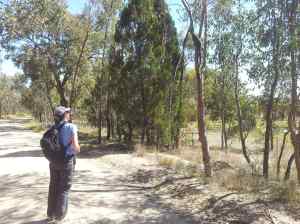
Here is a pic of Peter (on the right) and I at a control:

Our first control after dark was a maximum point value control. It was in a subtle gully (the course setter just loved those subtle features). We attacked it from above, after taking a bearing over 400m to steep ground. We would have been better taking a bearing about 20 less degrees to a flat part of ground and then coming in about 50m. There was over an hour of stuffing about until we finally got it. We really did think, do we cut our losses and get out of here, but we wanted those 100 points!
We visited a few more controls in the dark after that without any difficulty. I don’t think we were that much slower for them in the dark than what we would have been during daylight. BSAR wanted all of their teams to do some night rogaining because it helps develop search skills.
In the end, we came out with 1360 points which was 4th in the mixed (gender) category. If not for the stuffing around on the 100 point control, we might have even won the category. We would have never come first overall, as that would take beating he men like Merv Terese.
It was a quick, but substantial feed, from the food on offer at the hash house and into the tent at 1am Sunday morning. Still going to be a big day on Sunday.
BSAR practice
The VRA puts on breakfasts after rogaines that finish well into the night. This is to encourage tired rogainers not to leave and drive while tired. The result of this policy is I had a generous helping of sausages, bacon and eggs for breakfast. After this, the rogainers left, while BSAR got into search specific practice. Today was a briefing on radios, GPS units, line searching practice and a sked evacuation. I was asked to do part of the radio briefings.
BSAR use both UHF FM CB radios and VHF FM police radios. The CB radios is a class license available to the public. On most searches this is not a problem, but the public can interfere with search traffic. This has happened when a search was on a mountian top within line of sight of a major population area. Still, Police radio is a limited resource, and BSAR continue to use CB radios. They are typically used for group to group communication and intra-group. Often they ended up being used as a substitute for Police Radio. The Police radios are a Motorola 2 way radio with 5 watt capability. They are a standard issue across country police, still being analog based. There is talk of it going over to P25 at some stage, but this might be still a few years away. Most searches have support from Police Comms, who set up portable repeaters. Some searches have had two of these. Some searches have none, which means we end up on some divisional channel and get to hear about what divisional van is attending what break and enter event. Sounds exciting, but is very boring after a while and completely irrelevant to a search.
The simulated search was a line search. A line search is where a group of searches search in a line (hence the name) with the intention that the ground between each searcher is covered thoroughly. Unlike feature searching, there is no need for a subject to be able to talk or respond to calling. Line searching is much more thorough, but covers much less ground. BSAR searchers would spend less than 20% of total real search time doing line searches. Our group was searching a different area to where a (simulated) unconscious person was found. We were called over to assist with a sked evacuation. A sked is a stretcher that is also a sled. There are handles for 6 people to carry at a time, and it is hard work. In real life, if a sked evacuation was to occur over a longer distance, poles would need to be made up – and the sked kit has some saws in order for poles to be made from nearby trees.
After this, things wrapped up for the BSAR practice weekend, and it was time to head home for most.
Onwards to Mt Speculation VK3/VE-022
Given I was now in north east Victoria, I had planned to spend the next three days activating summits in the area. I had planned on a 8 summit trip, but after a hard 12 hour rogaine on the Saturday (with feet a bit sore), I thought I needed to take it down a notch. I headed off from the rogaine area and arrived at Lake Cobbler by about 4pm local. The road is a little rough on the final climb up to the lake, but still quite passable in a 2WD. I decided to park at the Lake Cobbler link track rather than by the hut at the lake itself. I then headed off for what I thought would be a 2 1/2 to 3 hour walk to Camp Creek near Mt Speculation.
It ended up being being about 3 1/2 hours as there must have been well over 100 trees fallen over the 4WD track. The track was due to open today (1st November), and no doubt 4WD’ers will be in there with chain saws to clear the road. Some of these fallen trees have trunks over 1 metre thick. It would take days to clear the road. I saw elsewhere that Parks Victoria had simply gone in with bulldozers and simply pushed the timber to one side. They might need a bulldozer to reopen Speculation Road.
Camp Creek was my water source for camping at Mt Speculation. After filling right up with 6 litres, enough for that night and most of the next day, it was up to the summit for activating. It was great local contacts, nothing DX. I again used the squid pole and the end fed wire, which was to be my setup for the rest of the trip. Here are some pics taken the next morning before I pulled down the antenna:
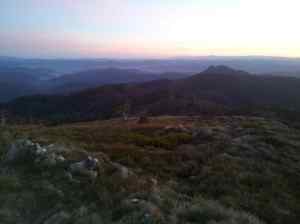
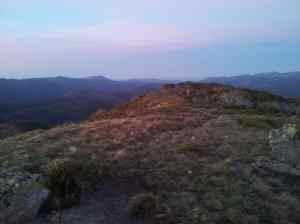

Mt Despair VK3/VE-043
After packing up the tent and heading off shortly after sunrise on the Monday, I used the Australian Alpine Walking Track heading north along the ridge, rather than using the old road heading north out of Camp Creek. The walking track is a little hard to follow, and I got off it a few times. It is a very steep descent heading down from the ridge to the old Jeep track heading towards Catherine Saddle. I think if I was going the other way, I would be heading through Camp Creek instead, much easier.
From Catherine Saddle, it’s back to walking track up to Mt Despair. The track is a little steep to start, but this section is quite short and it is mostly a gentle climb to the summit. A group had gone through and slashed back much of the regrowth, so the track is easy to follow. There is a number of fallen trees, but they were about every 150m or so, rather than a fallen tree every 30m disaster zone closer to Lake Cobbler.
I arrived at the summit and again set up the squid pole resting in a tree. Again lots of easy local contacts, no DX. I could hear some DX CW stations calling, but could not make out even whole characters. Seems to be a theme with this antenna. Mt Despair does not have many views, so I took no photos from here.
The Razor Vk3/VE-044
The track heads down, gently at first and then steeply to the saddle between Mt Despair and The Razor. The track at the saddle and onwards becomes much more rocky, up and down and scrambly. The fires have taken away much of the shade of this section. I don’t know if it is because I have done this track a few times before, or are more experienced, but I had little problems in following the track. There were a few sections that were badly overgrown, and it is not possible to rely only on track markers. The track makes its way up to a foothill of The Razor – a lower summit on the same ridge, before turing off towards Viking Saddle. I continued on towards The Razor. This section has had no love since the last fires and had no designated track. There is one small section of really tough regrowth, but towards the summit, it thins out. Mostly, it pays to stay about 20 metres below the ridge line as it is quite rough. I ended up operating about 15 vertical metres below the actual summit, but access up to the top was easy from there.
Again, good local contacts, but I at least got NS7P into the log with a workable signal. It was still weak, but I could at least hear real morse, rather than what I had been hearing before: a hint of a dit or a dah here and there, but nothing more. I think I will need the vertical back for real DX action!
Here are some pics from The Razor:
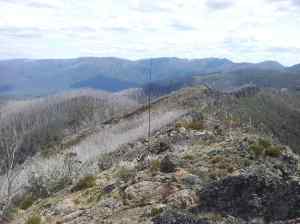
Looking back towards Mt Despair and Mt Speculation:

Looking north east. Mt Bogong, Mt Feathertop and Mt Hotham are visible (if you know what to look for):

With that, it was time to pack up and head back about 30 or so minutes to the track. Seemed easier going the other way. The Australian Alpine Walking Track heads south east from a minor hill on The Razor ridge towards Viking Saddle. This section of track had been slashed, so it was fairly easy going. It was much, much easier than last time I was here. I got into Viking Saddle and made camp. There is a track heading north east from here down to a spring. Water was flowing so it was reasonably easy water trip and I drew enough to get me through camp and the next day when I intended to return to Camp Creek.
The Viking VK3/VE-037
Up early the next morning for The Viking activation. This time, I left the tent and most of my gear, only needing to carry a first aid kit, the FT-817, batteries, misc radio gear, the antenna and the squid pole (and of course the backpack and some water) up the mountain for the activation. There is a 3m rock climb on the way up, but this is fairly easy. I did not even need to take my pack off either on the ascent, or when I descended back the same way. I arrived around 8am and then setup the squid pole almost right at the summit. Again, easy local contacts, no luck on DX. Here are some pics:

Part of the Cross Cut Saw, Mt Buggery, Mt Speculation and Mt Despair (lower right) from The Viking:

Mt Cobbler (left centre) and The Razor (lower right) from The Viking:

After this, I packed up, headed back down to Viking Saddle and there packed up the tent. My plan was to go to Camp Creek, back along The Razor ridge (but only on the AAWT avoiding the summit), over Mt Despair, and then using the old vehicle track from Catherine Saddle up to Camp Creek. I arrived at 4pm. I had then decided to go for a longer day and try to camp just underneath Mt Cobbler, at the junction of the track that comes up from Lake Cobbler. I estimated this might take another 3 walking hours. It would be a big day, but it would give me the convenience of leaving the tent where I camped, rather than hauling it up the mountain. I ended up doing this, after going over all of those fallen trees on the Speculation Road. There were plenty of trees on the walking track from near the Lake Cobbler track/Speculation Road junction as well. As I approached the ridge line, it was more pleasant walking, even though I was now very tired. I made camp just on dusk at the track junction.
Mt Cobbler VK3/VE-027
Next morning (the last of the trip), up early again and headed up the mountain. The summit is separated from the rest of the high part of the mountain by a small little drop. This must be crossed to get into the activation zone, but it is quite easy to do. I operated just below the summit. It was plenty of contacts, but local only. Some more pics:
The first pic has all of the summits I had activated up to now in the picture. Here I did not rest the pole up against a tree, but secured it with a ratchet:
We have Mt Buller, Mt Stirling and even Mt Torbreck poking up in the distance. I’ve shown you most of the Victorian high country on this trip!

It was time to head back down to the tent about 40 minutes away, pack up and head down to the awaiting car. This took much longer because of the large number of fallen trees. It was nice to finally make it, but there was a fallen sign about the dangers of all of the fallen trees at the track head. No such sign at other start of the track system that I used. It is not so dangerous as just being inconvenient, but I also would observe that inexperienced people could lose the track and get lost in these conditions.
VK3/VE-103
The final summit of the trip is not far from Lake Cobbler. After about a 2km drive to a saddle, it was time to whip out the backpack again for one last climb. This was a sharp (but with some breaks) 150m climb up to the summit. This summit is directly accessible with a 4WD, but not a Prius. By this stage, I was looking for a quick activation, but in the end, I operated for about one hour on top. Peter VK3PF worked me on every summit on this trip. Also Glenn VK3YY, disappearing from work out to the car when he saw spotted on sotawatch.
A most enjoyable trip, even if a bit of hard work. I am 52 SOTA activation points heavier, and hopefully a few pounds lighter.
Regards, 73 Wayne VK3WAM

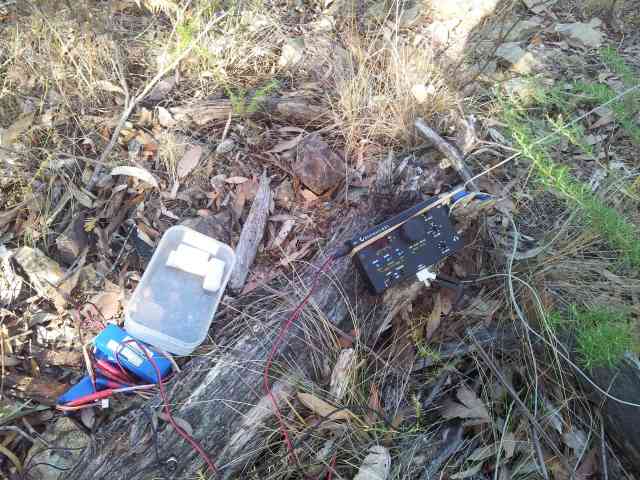




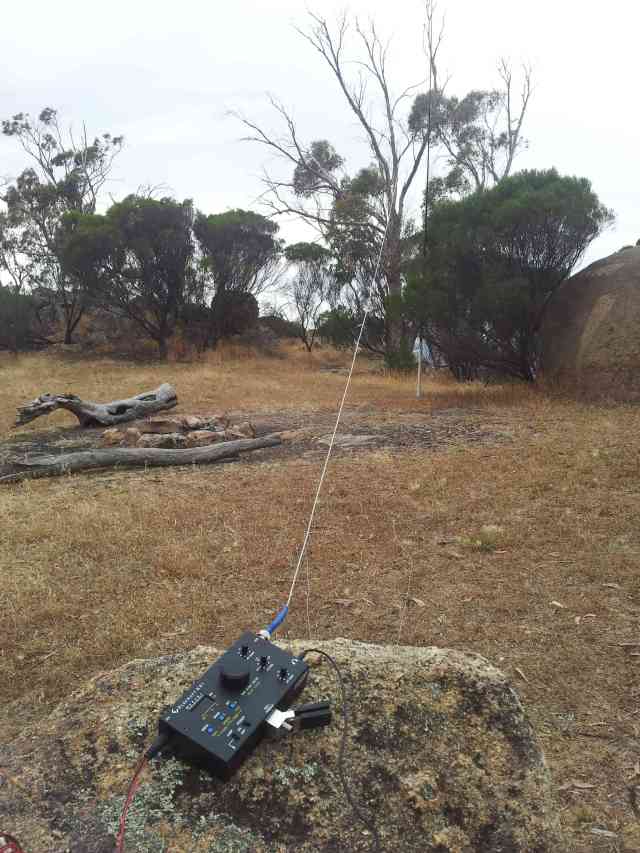




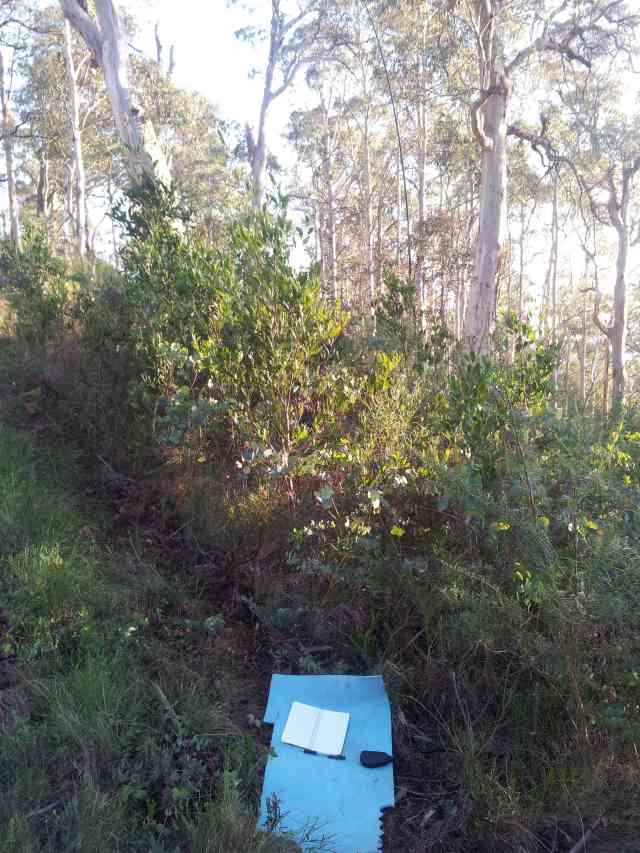















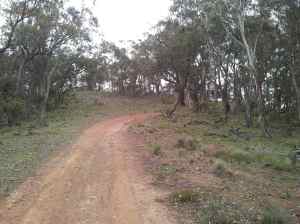

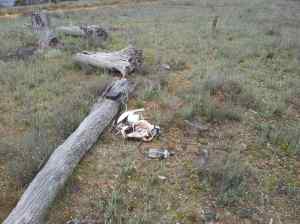
















You must be logged in to post a comment.